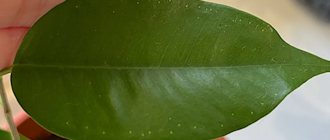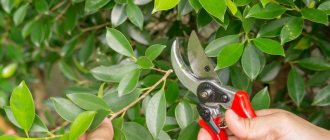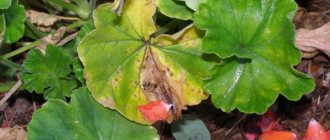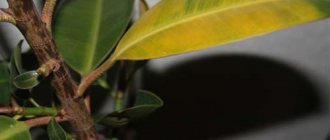Indoor plants, as well as above-ground plants, are prone to various diseases. The home flower changes, the foliage and stems become spotted, turn yellow, dry out and fall off. There can be many reasons why ficus castings turn yellow. Before we begin to eliminate the disease, it is worth considering each of them in more detail.
Ficus leaves turn yellow: reasons
Diseases of indoor plants can be perceived very acutely by gardeners and raise a lot of questions. But yellowing of the ficus does not always indicate a problem, insufficient care or disease. At one time, usually two or three leaves turn yellow and fall off, but in their place fresh, young, green leaves grow. But if you notice that the ficus has suddenly turned yellow, the problem affects all leaves, you only have yourself to blame for the disease of the houseplant.
Ficus leaves turn yellow, reasons:
- Incorrect transplant. Perhaps the pot is large, so the root system does not have time to fill all the soil.
- Reduced temperature. Ficus is a heat-loving plant, so in no case is it recommended to lower the temperature below 18 degrees. If the room is quite cold in winter, be sure to use heaters. But under no circumstances place the plant near a heating radiator.
- Lack of minerals and nutrients. Ficuses, like any other plants, need fertilizers, especially if they are transplanted to a new location. Follow the watering schedule, because in conditions of lack of water the plant can quickly wither . But not only a lack of water, but also its excessive amount causes yellowing of the foliage. Even if you flooded the plant with a large amount of water once, there is a risk of its death.
- Diseases. During transplantation, pay attention to the roots and stems to see if there are any suspicious deposits or insects on them. Often the causes of darkening of leaves are pests, bacteria and viruses.
Healthy plant
Top dressing
A lack of useful components in the soil can cause a disruption in the life systems of the ficus. It is important to remember that in the spring this plant is actively growing, so mineral fertilizer should be given a couple of times every two weeks. In winter, the amount of fertilizing should be reduced, since the plant is dormant. Also, from October to February, it is advisable to reduce the amount of watering. Due to the lack of summer sun, the plant almost completely stops photosynthesis, so the root system does not absorb water as actively. During this period, the ficus independently sheds excess foliage.
Nitrogen and magnesium are considered the leaders among useful agents for the crown of a flower. Nitrogen allows the ficus to quickly grow new full leaves, and magnesium protects old foliage from aging. In order to compensate for the lack of magnesium in the soil, you can use the following mineral fertilizers:
- magnesium sulfate;
- potassium magnesia;
- dolomite flour.
If young leaves dry out, the ficus most likely lacks iron. In this case, the plant should be fertilized with ferrovite.
The feeding procedure includes a number of preparations. First of all, the flower should be watered a day before fertilizing. This precaution will protect the plant roots from burns by active mineral components. The fertilization procedure must be carried out according to the instructions. Some types of fertilizer should be buried under the top layer of soil, while others can simply be worked on top of the soil. There are also special solutions for spraying foliage.
During illness, ficus cannot be treated with the full norm of fertilizing. This also applies to the new fertilizer. The dosage of new minerals should be half as much. You should ensure that all manipulations bring a positive effect. If during treatment the ficus continues to shed leaves and quickly turns yellow, the treatment does not work.
Why do ficus leaves turn yellow in summer?
It is recommended to remove the plant from the pot, cut off all damaged roots, and replant it in new soil. Do not use old soil for replanting other plants. It must be thrown away, because mold spores or some other pathogenic microorganisms can multiply in it. Other plants can grow in this soil, but will also become diseased.
Why do ficus leaves turn yellow in summer?
- Remove the plants from the sunny side, since under direct sunlight the ficus can also darken and dry out.
- Sometimes it is very difficult to determine when a ficus needs watering. The plant needs a lot of moisture, but if you flood the crop with water even once, the roots may begin to rot, mold and pathogens may multiply, leading to the death of the plant. That is why it is necessary to follow the watering regime.
- You can check the lack of moisture in the following way. To do this, take a dry stick, a match or a wooden skewer will do, and place it in the soil. You need to leave it in the ground for a few minutes and then pull it out. If the stick is completely dry, you need to water the plants.
- If you are guilty of excessive amounts of moisture, then it is better to limit watering for two weeks, reducing it to a minimum. Accordingly, at this time it is necessary to water the plant in small quantities.
Yellowing
Consequences of improper care
With improper care, not only yellow spots appear, but the entire plant suffers completely. Improper watering is one of the main reasons for the appearance of yellowness. Ficuses do not like heavy watering. It is worth moisturizing the soil as soon as it is completely dry.
Advice! To determine the dryness of the soil, stick a stick into the soil. If you take it out, it will be dry, which means it’s time to water.
If yellow spots appear on the ficus, you should limit watering for two weeks. If the flower dries and withers, it is necessary to transplant it to a new place. Before planting, remove any roots that have begun to rot.
Important! When watering with soft water, a white crust appears on the surface of the soil and on the underside of the flowerpot.
A lack of microelements affects the flower; it begins to dry out and may die. In order for the plant to develop properly, there must be a sufficient amount of nutrients in the soil. Deficiency leads to metabolic disorders, the plant develops poorly, the shape of the flower and the color of the leaf change.
Micronutrient deficiency symptoms:
- the plant sheds its leaves prematurely, especially the lower tier;
- stems are too fragile;
- poorly developed root system;
- the appearance of pale and yellow spots on the leaf.
An excess of minerals leads to various problems:
- poor flower development, especially in summer;
- the leaf blade dries at the edges, cinnamon spots appear;
- stems are fragile and brittle;
- the leaves begin to wilt.
Why do ficus leaves turn yellow and fall off after fertilizing?
Why do ficus leaves turn yellow and fall off after fertilizing? With a deficiency or excessive amount of mineral supplements, not only the color, but also the shape of the foliage changes. They may dry out around the edges but be green in the center.
Symptoms of micronutrient deficiency:
- The plant falls and sheds its leaves mainly in the lower part. When you try to bend the stem, it breaks off easily. Excessive fragility indicates a deficiency of certain microelements.
- Insufficient development of the root system. If during transplantation of the crop you noticed thin and small roots, then the plant is not nourished enough. It needs feeding.
- If pale, yellow spots appear on the sheets. Not only a lack, but also an excess of fertilizers affects the condition of the plant. Yellow foliage may also indicate over-fertilization of the crop. However, in this case, not only yellow, but also brown spots appear. The leaves do not turn yellow, but immediately wither.
Spots on leaves
Ficus lyreformes - f. lyrata.
Perhaps the most spectacular of indoor ficuses is the lyre-shaped one. This species is distinguished by its leaves with a wavy surface and the large size of the tree (it can grow up to 2.5 meters). In a room, it is undesirable to place ficus lyreate close to other flowers; it requires a lot of space, although under natural conditions it can grow both in the depths of the forest and on its edge.
The unusually shaped leaves are directed upward, their length is about half a meter. At first, this ficus grows into one trunk; side shoots appear only at the age of 4-5 years. The rough bark covering the trunks is light brown with a gray tint. This large “flower” is only for spacious rooms.
Thin, harsh leaves of a dense green color with a glossy surface and a light green color on the inside. Green-yellow veins stand out brightly on the leaf. The leaves are up to 50 cm long and up to 25 cm wide, with wavy edges.
The most common varieties are:
- "Compacta" is a small tree covered with lush dark green foliage.
- "Philis Gred." It has a compact crown and large decorative leaves, reaching a length of almost 35 cm.
- "Bambino" is a miniature variety with densely planted leaves measuring about 25 cm.
What is the disease if the leaves of a ficus tree turn yellow and fall off?
Ficus is a plant that does not often get sick, but if not cared for properly, diseases can occur. Among the most common are the following.
What is the disease if the leaves of a ficus turn yellow and fall off:
- Gray rot. Brownish-yellow and gray spots appear on the leaves. In this case, the leaves do not turn yellow from the tips. The first manifestations of the disease appear in the center. Over time, the leaves dry out and fall off.
- Shield . This is a pest that sucks beneficial juices from the crop. Yellowish, brown spots appear on the leaves. Please note that there may be sticky spots on the back of the leaves, which can cause the crop to dry out.
- Spider mite . In this case, the plant may turn yellow, but a thin layer of cobwebs or film is observed on the stems. The plant withers and curls. This occurs on the back side of the leaf.
The leaves are falling
Ficus Binnendijka - f. binnendijkii
Another species suitable for growing at home is ficus Binnendijka or Benedicta. This is a plant with narrow, elongated leaves and thick aerial roots, which is why it is sometimes mistakenly called a bottle tree. Typically this species consists of shrubs or trees, which in apartment conditions reach about 1.5 meters.
The shoots are covered with bark, which, depending on age, can be light green, brown or gray. Elongated leaves with a sharp end, painted in a thick green tint. Typically, the leaf length is from 25 to 30 cm, and the width is from 4 to 5 cm. The vein running through the middle of the leaf blade is colored light green with a yellow tint. The upper part of the sheet is glossy, and the lower part is matte.
In indoor floriculture, Ficus Benedict is represented by the following varieties:
- Ali (Alii) has a dark brown trunk with light strokes and is relatively miniature in size; unlike natural species, it does not grow above 2 m in height.
- Amstel King - also a low-growing variety, differs from Ali in having wider leaves (7 cm wide)
- Amstel Queen is a variety similar to Amstel King, with slightly less wide leaf blades.
- Amstel Gold, or Variegata, is a variegated variety with yellow-green leaves that especially needs good lighting.
Ficus leaves are turning yellow - what to do?
It is necessary to use prevention, as well as carefully care for the plant. Be sure to monitor the temperature and do not allow it to fluctuate. Both a decrease and an increase in temperature can affect the condition of the crop.
Ficus leaves are turning yellow, what to do:
- If the plants have lost a large number of leaves, an urgent transplant into new soil is necessary. Pruning, watering or additional feeding does not solve anything. Mold spores, or pests, live in the soil in which the plant is located. It is recommended to completely dig the plant out of the pot and replant it in new soil.
- Before placing the crop in new soil, it is best to wash the roots with a weak solution of potassium permanganate. This will kill mold spores, as well as bacteria and viruses that are on the roots.
- If you see that the roots are slippery or have an unpleasant smell, be sure to cut them with scissors. Treat the tips with a special product that improves rooting and promotes the survival of the crop in a new place.
Bonsai
Tea
Tea brewing improves the structure of the soil and fills it with essential nutrients. To get rid of yellow leaves, add 1-2 tbsp to the flower pot. l. dried tea leaves and spill the soil with a small amount of settled water. After 3-4 weeks, replace the old tea leaves with a fresh portion and continue watering as usual.
- Author: iarriba
Rate this article:
- 5
- 4
- 3
- 2
- 1
(6 votes, average: 3.3 out of 5)
Share with your friends!
Why do ficus leaves turn yellow and fall off in winter?
Winter time is a period when a large number of plants go into hibernation. This does not mean that they wither or dry out. But the crops are at rest, and the flow of juice inside the stems and leaves slows down. This often happens with ficus in winter.
Why do ficus leaves turn yellow and fall off in winter:
- There is no need to worry, especially if the temperature outside has dropped. Be sure to monitor the temperature and increase it if necessary. Ficus is a plant that cannot be placed on the veranda or balcony. The crop is not intended for the winter garden, as it does not tolerate cold air or temperature drops below 18 degrees.
- In winter, the plant may be located near heating radiators, which dries out the soil and can cause a lack of fluid and moisture. Therefore, water the ficus twice a week, but not very much. Replace additional watering by spraying the foliage and stems with a spray bottle. Once every 3 weeks, add mineral supplements and fertilizers to the soil in which the ficus grows.
- Yellowing at the bottom indicates a seasonal change of leaves and the rapid growth of new elements on the stem. Most likely, new leaves will appear over time. However, if there are more yellow leaves below, it makes sense to think about pests and rot. First of all, when the roots are damaged, the lower leaves begin to change color; over time, the disease spreads to the top of the crop.
Leaves are drying
Preventative treatment
To avoid yellowing foliage, first of all you should provide the ficus with maximum care. It should contain a balanced watering regime, a warm and bright room, as well as mineral supplements. Often, home maintenance of different types of flowers may differ from each other.
So, Ficus benjamina needs more sunlight, but even such a light-loving flower needs to be provided with shade in the middle of the day. Watering these plants has a certain schedule: the soil must have time to dry completely. Ampelous ficus species require an increased amount of moisture in the air and frequent watering. It is recommended to put expanded clay in a tray of these types and periodically moisten it.
In addition, there are a number of preventative measures to help protect the foliage from yellowing:
- Once a month, the ficus crown should be treated with a soap solution. This procedure is especially important for plants located on an open loggia or growing outside.
- After purchasing a flower, you should observe quarantine for some time. This will help identify diseases in the flower and protect other plants from infection, which can cause yellowing of the leaves.
- You should carry out sanitary pruning in a timely manner, remove dry leaves and straighten the tips of the shoots. The lower shoots should be cut off completely, as they can spread along the ground and take root.
- It is necessary to maintain distance between pots, even if the flowers in them are of the same type. When too crowded, plants begin to wither and lose leaves.
- Ficus transplantation should not happen too often. It is recommended to do this no more than 2 times a year. To renew the soil of an adult plant, experienced florists remove only the top layer of soil.
- You should choose the optimal location for growing your ficus to limit the number of times you move the pot.
Why do Ficus Benjamin leaves turn yellow and fall off?
Ficus benjamina is an unpretentious plant, this does not mean that it does not require care. There is a change in color that occurs immediately after the acquisition of the culture. The fact is that in a store or warehouse, constant temperature and humidity are maintained.
Why do Ficus Benjamin leaves turn yellow and fall off:
- Features of care at home may differ, and the plant reacts sharply to the change.
- It is best to purchase a new Ficus Benjamin in the summer, as at this time it better adapts to environmental conditions.
- Under no circumstances should you replant it immediately after purchasing a plant.
Stains
In the spring, the lower leaves of the ficus turn yellow: reasons
Don’t be surprised if in the spring you see falling, yellowing ficus leaves from below.
In the spring, the lower leaves of the ficus turn yellow, reasons:
- This is normal since leaf change begins at the bottom of the plant. The transition phase lasts several weeks.
- At the initial stage, the lower leaves change color, then they fall off, the stem becomes rough, hard, hard, and the plant stretches upward. At the very top a large number of new young and bright green leaves appear.
- This is due to the fact that in spring the amount of juice increases and its circulation within the stems increases. This provokes the change of leaves, their new growth.
Healthy plant
Why do the leaves of rubber ficus turn yellow and fall off?
In winter, the rubber-bearing ficus needs additional moistening of the leaves and stems using a sprayer. The plant suffers greatly from excessive waterlogging.
Why do the leaves of rubber ficus turn yellow and fall off:
- This is often observed in winter, in conditions of low temperature and a lot of moisture. Rubber-bearing ficus is one of the most heat-loving plant species, so the optimal temperature in the room is 20-23 degrees.
- A maximum increase of up to 28 degrees is allowed. If one or two leaves have fallen from below, do not worry or worry. But if you notice that the leaves change color and fall off constantly, their number increases, and the stem gradually becomes bald, you need to urgently sound the alarm.
- It is necessary to transplant the plant into new soil, and avoid excessive waterlogging of the substrate.
Update
How to prevent leaves from turning yellow
Remember the dangers of excessive watering: excess moisture in the soil can cause fungus to appear. To prevent the leaves from losing their rich green color, protect them from direct sunlight and drafts, which even in summer can damage the plant, which is sensitive to heat and temperature changes.
Did you know? In India, bridges across ravines and shallow rivers are grown from the roots of a certain type of ficus. Roots are attached to bamboo sticks, which gradually grow to the opposite bank. Such “living” bridges are very strong and durable. The oldest bridge, according to scientists, is about 500 years old
.
The leaves of the ficus began to turn yellow and fall off after transplantation - is this normal?
Houseplants experience stress during a move. Therefore, ask the store in detail about the conditions in which the plant should be kept.
Why did the ficus leaves turn yellow and fall off after transplantation?
- Many people believe that if you change the environmental conditions of the ficus, it will immediately begin to grow better.
- This is the main mistake, since immediately after transplantation the plant quickly withers, dries out, its leaves turn yellow, fall off and the plant dies. It's better to wait about six months.
- Often the death of leaves is a physiological process, because once every 2-3 years the leaves change, but this does not happen to the entire plant, but only to a few of its elements.
A lot of interesting information about plants can be found in the articles on our website:
Ficus: what does this flower mean for home and office, what does it symbolize?
How to make a bonsai tree from ficus benjamina
Ficus: varieties, photos, diseases and home care
Magical herbs and plants: list, methods of use in magic
Iodine in the garden: application - tips for summer residents











